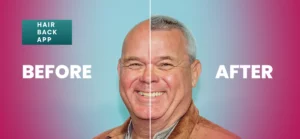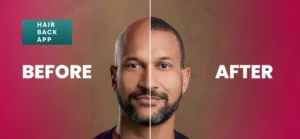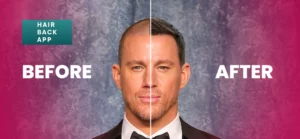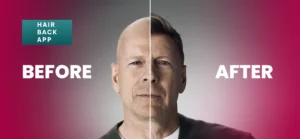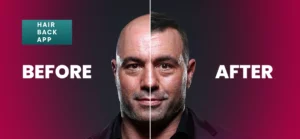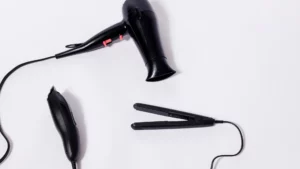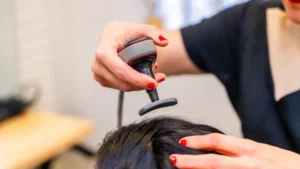Hair cloning techniques are one of the most promising advancements in hair restoration. Unlike traditional methods that rely on redistributing existing hair, these innovative techniques focus on replicating hair follicles to provide a long-term solution for hair loss.
As research progresses, the potential for hair cloning to revolutionize the industry grows stronger.
My name is Emma Wright, your resident hair transplant and restoration specialist. Today, we will take a look at some Hair Cloning Techniques.
This article explores how hair cloning techniques work, their effectiveness, and what the future holds for individuals struggling with one-sided hair loss and other forms of baldness.
What Are Hair Cloning Techniques?
Hair cloning techniques involve extracting hair follicle cells, multiplying them in a lab, and then re-implanting them into areas experiencing hair thinning or baldness. The goal is to create an unlimited supply of hair-producing follicles, making hair restoration more effective and sustainable.
Scientists have been refining these methods for decades, and while they are not yet widely available, clinical trials and advancements are bringing them closer to reality.
How Do Hair Cloning Techniques Work?
The process of hair cloning techniques follows a few essential steps, each designed to ensure the successful multiplication and implantation of hair follicles.
- Cell Extraction: A small sample of hair follicle cells is carefully removed from the scalp. These cells are typically sourced from areas resistant to balding, such as the back or sides of the head, ensuring they retain their natural hair-producing properties.
- Cell Cultivation: The extracted cells are placed in a controlled laboratory environment, where they are stimulated to multiply. Scientists use advanced tissue engineering techniques to create a large number of viable follicular units from just a small sample.
- Follicle Conditioning: Before implantation, the cloned follicles are conditioned to ensure they can integrate well into the recipient area. This step is crucial for increasing the survival rate of newly implanted follicles.
- Implantation: Once the cloned follicles are mature and stable, they are carefully implanted into areas experiencing thinning or baldness. The procedure is similar to traditional transplants but does not rely on limited donor hair.
- Growth Monitoring: Specialists monitor the newly implanted follicles over time to track their integration, hair growth patterns, and overall success. This helps in refining the procedure for future applications.
This method differs from conventional hair loss treatments, which focus on slowing hair loss or redistributing existing hair rather than regenerating new follicles
Different Types of Hair Cloning Techniques
Several hair cloning techniques are currently being explored, each utilizing different scientific approaches to follicle replication. These methods aim to create a sustainable, long-term solution for individuals experiencing one-sided hair loss or significant hair thinning.
Dermal Papilla Cell Culturing
Dermal papilla cells are vital for hair follicle development and regeneration. This method involves extracting dermal papilla cells from healthy hair follicles, multiplying them in a lab, and then injecting them into the scalp.
These cells communicate with surrounding tissues to reactivate dormant follicles and stimulate new hair growth. Research indicates that this technique could be particularly effective for individuals in the early stages of hair loss.
Hair Follicle Neogenesis
This innovative approach focuses on growing entirely new hair follicles from stem cells. Scientists extract stem cells from the patient’s body, culture them in controlled conditions, and then implant them into bald areas.
The goal is to mimic the natural process of hair follicle development, making this method an ideal solution for those with limited donor hair. If successful, it could eliminate the need for hair transplants for long hair procedures by providing an unlimited supply of new follicles.
Cloned Follicle Implantation
In this experimental method, complete hair follicles are cloned in a laboratory before being implanted into the scalp. Unlike traditional hair transplants, where existing follicles are relocated, this technique aims to generate entirely new, genetically identical follicles.
Although still under research, scientists believe this approach could provide a permanent solution for baldness, eliminating the need for repeat procedures.
Cell-Based Therapy with Growth Factors
This method integrates hair cloning techniques with growth factor treatments to enhance follicle development. By combining cloned hair cells with platelet-rich plasma (PRP) or other regenerative compounds, researchers hope to speed up hair growth and improve follicle survival rates.
This method could be a game-changer for those seeking faster, more reliable results.
3D Hair Follicle Printing
Scientists are now exploring the possibility of using 3D bioprinting technology to create functional hair follicles. This futuristic approach involves printing follicle structures layer by layer using bioengineered cells. If perfected, this could revolutionize the field by producing thousands of hair follicles for implantation in a single procedure.
Each of these hair cloning techniques brings unique advantages and challenges, but they collectively represent a significant leap forward in the quest for effective hair loss treatments.
Advantages of Hair Cloning Techniques
Hair cloning techniques offer several benefits compared to traditional hair transplant for long hair and other restoration methods, making them a groundbreaking approach in hair restoration.
- Unlimited Hair Supply: Unlike conventional transplants that depend on donor hair, hair cloning can produce an unlimited supply of new follicles by multiplying cells in a lab.
- Potentially Permanent Solution: This technique could provide a long-lasting or even permanent fix, unlike medications that require continuous use to maintain results.
- Minimal Invasiveness: The procedure is less invasive than traditional hair transplants, reducing the need for surgery, minimizing discomfort, and shortening recovery time.
- More Natural Results: Since cloned follicles are developed from the patient’s own cells, the newly grown hair matches natural hair in texture, density, and growth patterns.
- Better Suitability for Extensive Hair Loss: Individuals with severe baldness or one-sided hair loss who lack sufficient donor hair may find hair cloning to be a more viable solution.
- Reduced Risk of Scarring: Since fewer incisions are needed, the risk of visible scarring is lower than with conventional transplants.
- Potential for Faster Hair Growth: Some cloning methods incorporate regenerative treatments that may accelerate the hair growth cycle, providing quicker results.
These advantages make hair cloning techniques a promising alternative to existing hair loss treatments, offering new hope for individuals seeking a reliable and natural-looking restoration.

Challenges and Limitations
Despite its potential, hair cloning techniques still face several challenges that must be addressed before they become widely available.
- Scientific and Technical Hurdles: Successfully cloning and implanting hair follicles without immune rejection remains a complex process. Researchers are still working on ways to ensure the long-term survival of cloned follicles.
- Regulatory Approvals: Since hair cloning is a relatively new medical advancement, it requires extensive clinical trials and approval from health authorities before being offered to the public.
- Cost Considerations: Early treatments are expected to be expensive, making them inaccessible to many individuals until the technology becomes more widespread.
- Uncertain Longevity: Scientists are still determining whether cloned follicles will continue to grow hair indefinitely or if they will require ongoing maintenance.
- Scalability Issues: Large-scale production of viable hair follicles remains a challenge, as laboratories need to refine techniques to produce consistent, high-quality results.
- Ethical and Legal Concerns: Some ethical concerns have been raised regarding genetic modification and the implications of cloning human tissue for cosmetic purposes.
- Limited Availability: Even after approval, hair cloning techniques may initially be restricted to select clinics, limiting widespread access.
These challenges indicate that while hair cloning techniques have great promise, they are not yet a mainstream hair loss treatment.
How Hair Cloning Compares to Other Hair Restoration Methods
While hair cloning techniques are advancing, traditional hair loss treatments remain the primary option for most people. Here’s how they compare:
| Feature | Hair Cloning Techniques | Traditional Hair Transplants | Medications (Minoxidil, Finasteride) |
| Hair Supply | Unlimited (once perfected) | Limited to donor area | No new hair generated |
| Invasiveness | Minimally invasive | Requires surgery | Non-invasive |
| Effectiveness | Promising, still in testing | High success rate | Varies per individual |
| Long-Term Results | Still being studied | Permanent in many cases | Temporary, requires continuous use |
For individuals considering restoration options, understanding the differences is essential. Some may benefit more from a hair transplant for long hair, while others might wait for cloning advancements.
When Will Hair Cloning Be Available?
Currently, hair cloning techniques are undergoing clinical trials, with experts estimating that commercial availability may take another 5-10 years. Researchers are working to refine the process, improve follicle survival rates, and ensure the long-term success of cloned hair before the technology can be widely offered.
While significant progress has been made, regulatory approvals, ethical considerations, and large-scale production hurdles still need to be addressed.
Clinical trials must demonstrate both safety and effectiveness before global health organizations approve the treatment for widespread use.
For now, individuals seeking immediate solutions may opt for hair transplant for long hair or other proven hair loss treatments like medications and laser therapy.
However, staying informed about developments in hair cloning techniques can help those planning for future restoration options, as this innovative technology may soon provide a more permanent and natural-looking solution for one-sided hair loss and other forms of baldness.
What to Expect in the Future of Hair Cloning
With continued investment and research, the future of hair cloning techniques looks highly promising. Scientists are focused on several key areas to make this technology widely accessible and effective:
- Enhancing Follicle Survival Rates: Researchers are refining methods to improve how cloned follicles integrate into the scalp, ensuring they continue producing healthy hair over time.
- Reducing Treatment Costs: As technology advances, costs are expected to decrease, making hair cloning more affordable for a broader audience.
- Increasing Availability: Once approved, more clinics and trained professionals will be equipped to offer hair cloning, expanding its accessibility worldwide.
- Accelerating Growth Cycles: Scientists are investigating ways to speed up hair growth after implantation, reducing the waiting period for visible results.
- Combining with Other Hair Loss Treatments: Hair cloning may eventually be used alongside hair loss treatments such as PRP therapy or stem cell injections to enhance results.
- Personalized Hair Restoration: Future developments may allow for customized treatments, adjusting follicle characteristics to match natural hair color, texture, and density.
As research progresses, hair cloning techniques could revolutionize the industry, offering a permanent solution for conditions like one-sided hair loss and severe baldness
Until then, those undergoing restoration procedures can still benefit from expert recommendations on the best haircut after a hair transplant to maintain their new look.
Conclusion
Hair cloning techniques represent an exciting breakthrough in the fight against hair loss. As research continues, these innovative methods may soon provide a long-term solution for those struggling with one-sided hair loss and other forms of baldness.
While hair cloning is not yet widely available, staying updated on its progress ensures that individuals can make informed decisions about their hair restoration journey.
In the meantime, other hair loss treatments and procedures like hair transplant for long hair remain viable options for those seeking solutions today.


